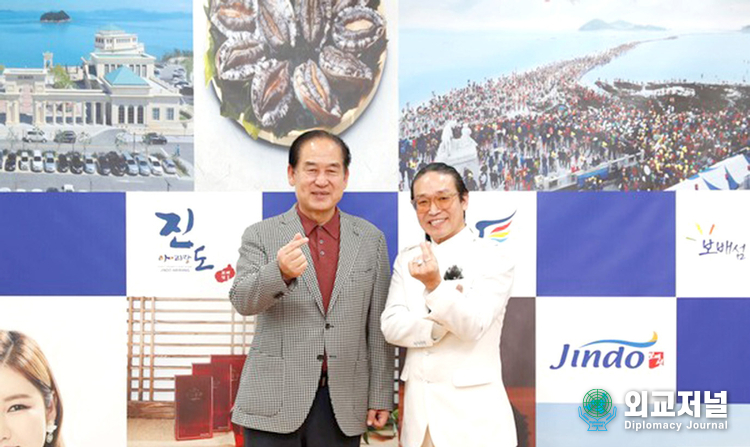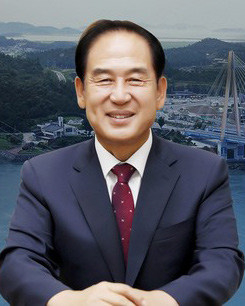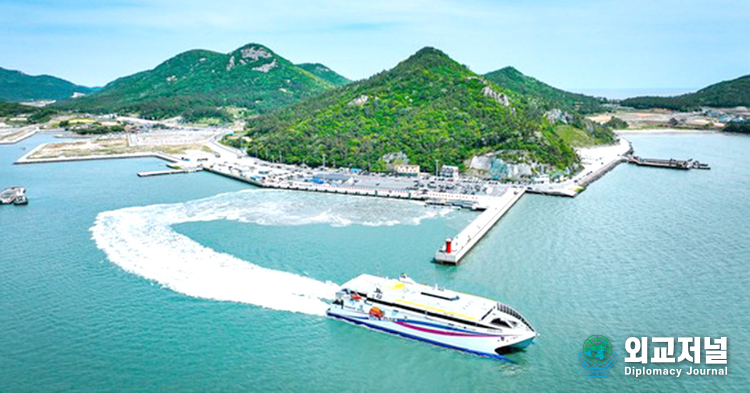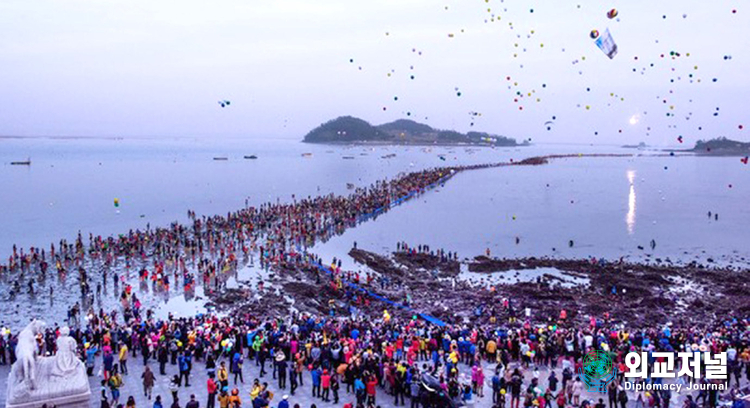By Reporter Yang Raeo Jin
Mayor Kim Hee-soo of the Jindo Coun-ty of the Jeolla-nam-do Province, in the opinion of many people in Korea, is a person who gives the impression of a man with ‘A Great Stone Face’ ap-pearing in the story of a great American writer, Nathaniel Howthorne (1804-1864), who authored the book.
Shortly after the American Civil War, a boy named Ernest hears from his mother that a child resembling a large rock face on a rocky hill will be born and become a great fig-ure.

Ernest lives honestly and sincerely in expectation of meeting such a person when he grows up--thinking about how he will live like the person with ‘a great stone face.’
Over the years, he meets with many famous rich peo-ple, generals, politicians, and poets, but he fails to find one looking as good as the big rock face.’
One day when Ernest passed middle age, there was a time when he addressed the public, and a poet who was listening to the speech shouts that Er-nest is the "big rock face."

However, Ernest, who has finished what he had to say, hopes in his heart that a wiser and better person than he will appear as a virtuous person like a big rock face.
It shows that great human values are not in worldly things such as money, honor, or power, but in the consistency of words, ideas, and life obtained through constant effort and performance.
Although he was not a very highly educated or famous pol-itician, it is fortunate for Jin-do-gun that a person who was born and raised in Jindo-gun and who started as a public of-ficial in 1974 and worked hard together became the leader of the Jindo County.
Some politicians ‘parachute down’ with a high degree of knowledge, authority, and cen-tral political connections, and others may be greedy politi-cians involved in corruption. However, many people tend to think that Mayor Kim Hee-soo is a pure native local leader who can serve and devote him-self honestly and faithfully to the people and country of Jin-do.
After four times of challeng-es, Mayor Kim was chosen by the people of Jindo County in the 2022 local government election to serve as a county mayor.
Jindo Island is a place that preserves the beautiful nature and clean environment of 230 islands, and is the only special folk culture and arts zone in Korea that has blossomed the cultural assets and brilliant culture and arts of the poetry, calligraphy, painting, and cre-ativity that have been passed down from ancestors since an-cient times.

Mayor Kim emphasizes that local specialties in agriculture and fisheries obtain from the culture and tourism industry and nature should be fostered as a key basic industry, which he cites as the key objectives of 2023.
For the development of the tourism industry in the Jindo County, the government has designated tourism as the main county policy and is mak-ing an all-out effort to carry it out.
In order to realize the coming tourism, the Jindo County is promoting tourism using vari-ous media and online contents.
The County is also is striving to attract tourists by develop-ing new tourism products such as Jindo-Jeju-linked products and Gwanmaedo Island travel plans.
Jindo will come up with in-centives for tourists to visit the Island by promoting projects that reflect tourism trends, such as operating a month-long living program on the Jindo Island, revitalizing camping tourism, and fostering wellbe-ing tourist attractions.
To realize home-stay tourist programs, tourists are led to stay in Jindo Island and enjoy travel by improving old tourist facilities, actively developing new tourist assets and visitor’s accommodation facilities, oper-ating tour buses, and improv-ing sanitary facilities.
In par ticular, the Jindo County government plans to actively accept reports of tour-ism inconveniences and im-prove difficulties so that more tourists will visit Jindo every year to prevent any inconve-nience felt by visiting tourists during their stay in Jindo.
Second, looking at compet-itive cultural and tourism resources, Jindo County’s most competitive cultural and tourism resources are by far traditional culture and arts represented by poetry, litera-ture, calligraphy, painting, and singing.
The Jindo County has been designated as Korea's only spe-cial zone for folk culture and arts, and it is recognized as a cultural and artistic home with four state-designated intangi-ble cultural assets, six desig-nated intangible cultural prop-erties in Jeollanam-do, and a number of public and private art galleries.
The Saturday Folk Travel Performance, which has been held every Saturday for 26 years this year, is a competi-tive cultural experience tour-ism program selected by the Ministry of Culture, Sports and Tourism by operating a va-riety of performance programs.
The natural environment is also a pride of Jindo Island. It is an attractive area for healing and natural tourist attractions, including Jodo-my-eon, Gwanmae Island's Dado-haehaesang National Park, Sebang sunset, a coastal drive course where you can enjoy the beauty of Jindo Island at a glance, and a mysterious sea route called the ‘Miracle of Modern Moses.’
The Jindo County is also a sacred place for national de-fense and has excellent histor-ical, educational and tourism resources.
Korean ancestors' patriotism can be seen through historical relics such as Uldolmok, the site of Admiral Yi Sun-sin's Myeongnyang Naval Battle Ground, Jindo Tower built to commemorate it and use it as a place for history education, Yongjang-seong Fortress, the base of Hangmong in Sam-byeolcho at the end of the Go-ryeo Dynasty, and the Tomb of Wangom
.
One of the competitive cul-tural and tourism resources is definitely to revitalize the in-dustry by nature's ‘Mysterious Sea Road.’ It is a plan to foster cultural industry and festival revitalization.
The Jindo Mysterious Sea Road Festival was widely known around the world in 1975 when Ambassador Pierre Landy of France in Seoul visit-ed and saw the Jindo Sea Road and introduced it to the French newspaper as a modern version of “Moses Miracle,’ and the Sea Road Festival celebrated its 43rd (2023.4.20~4.22) this year, starting with the first one in 1978.
It is a representative festival in the Jindo County, which is known nationwide enough to be selected as the best festival designated by the Ministry of Culture, Sports and Tourism and the Honorary Culture and
Tourism Festival.
During the festival, due to the tidal difference, the sea of about 2km between Hoedong-ni of Gogun-myeon and Modo-ri of Uisin-myeon opens at a width of 30 to 40 meters, attracting tens of thousands of tourists to Jindo Island every year to see the rare phenomenon.
This year, the basic frame-work of the traditional festival will be maintained, but the sea route visit program will be reproduced as media art by incorporating the latest digital technology to maximize the mystery of the sea route.
Through planning a substan-tial main program that fits the theme of the festival, diversifying the genre of opening performances, and operating side events that incorporate the latest technologies, it aims to increase the visitor rate and develop it into a stay-at-home tourism by making various programs at night.
The Jindo County will cre-ate a photo zone in the festival venue and create an experience program where tourists can participate in the festival.
The County will also build the foundation for globalization of the festival by expanding foreign tourists living in Korea and operating various global programs targeting foreign tourists so that the number of foreign tourists visiting the festival can increase every year.
The County also has a plan to foster and develop repre-sentative specialties and food presented by nature in Jindo Island.
Jindo Island's sea is rich in food such as plankton due to the development of cold water, and the meat quality of marine products is chewy due to the high flow rate.
Jindo Island's pride is a va-riety of marine products, in-cluding various seaweeds such as Tot, which account for the top production in the country, along with abalone, blue crab and ray fish.
The farmland is also abun-dant and so various agricultur-al products are cultivated. Jindo Dog, the biggest pride of Jindo Island, has been desig-nated as Natural Asset No. 53, protected and nurtured, and is Korea's representative state dog and world-class dog with excellent bravery, boldness, and loyalty.
Hongju wine is a traditional liquor of Jindo Island and is made using a herb called Zicho.
Jindo Hongju wine, which is red, is loved by drinkers be-cause its taste and aroma are as sweet and unique as its col-or.

And the future project that Jindo plans to foster as a bridgehead for the leap for-ward in the cultural industry is "Creating Jindo-style Santi-ago Pilgrimage Travel Couse (126km in six courses)."
As mentioned earlier, more tourists will visit Jindo Island thanks to themed travel prod-ucts.
In particular, by creating a Jindo-style Santiago pilgrim-age route (126km in six cours-es), Jindo intends to create a new wind in revitalizing the local economy by attracting tourists staying there.
In order to revitalize Nokjin tourist attractions and Hoe-dong tourist attractions, it plans to reorganize old facili-ties and develop infrastructure around tourist attractions.
It also plans to promote ma-rine tourism, such as creating a tourist coastal road with a good view, making Sebang Sunset a tourist attraction, and creating a luxury coast in Gomsol, Gwanmaedo Island.
In addition to maintaining facilities, the Jindo County will generously invest in tourism contents to develop various contents that tourists can ex-perience and enjoy, such as AR/VR, metaverse and media arts.
Private-capital project will also be encouraged so that various private capital devel-opment projects under way can be completed as soon as possi-ble.
Jindo Island is the third largest island in Korea after the Jeju Island and the Geoje Island, located at the end of the southwest coast of the country.
The area is about 360㎢, and it is located at 125°37'~126°28' east longitude and 34°08' ~34°35' north latitude.
Jindo-gun is the only special zone for folk culture and arts in Korea that has blossomed the brilliant culture and arts of po-etry, calligraphy, painting, and creativity, which consists of 230 islands, including 45 inhabited islands and 185 uninhabited islands.
It is a treasure island with many historical relics such as Yongjang Sanseong Fortress and Namdo Seokseong For-tress, as well as cultural heri-tages such as Ssitgimgut folk religious rite, drum dance, and Ganggangsullae ring dance of women.
And the Mysterious Sea Road in Hoedong Village, Gogun-my-eon, is a place where world-class tourist attractions are located.
Here are further details of in-formation about the Mysterious Sea Road Festival, one of the industries mainly fostered by Jindo-gun.
"Mysterious Sea Road" is a natural phenomenon in which the sea splits about twice a year in the 2km-wide sea be-tween Modo-ri, Uisin-myeon, Jindo-gun, and Hoedong-ri, Go-gun-myeon.
It has been said since ancient times that it was held with the earnest prayer of an old woman who lived here and separated from her family.
People have been living in Jindo Island for 500 years. At that time, the road to the island was not opened off the coast of Hoedong Village. In or-der to get to the nearby island (Geumho-do, Modo), the visi-tors had to use a raft. However, there were many tigers living near this village.
The name was Hodong (meaning Tiger Village) and it was given as such because it was a village where many ti-gers appeared.
Meanwhile, the villagers fled to Modo across the sea to avoid the tigers' attack.
However, all of them left the village by mistake, leav-ing their elderly grandmother named Ppong.

Grandma Ppong, who re-mained in the empty village, prayed every day to go out to the beach and meet her neigh-bors again.
Then one day, the Dragon King appeared in her dream and told her to step on the rainbow and enter the island because she was going to drop the rainbow into the sea at the end of February.
And at the end of February, the grandmother hurried out to the beach and prayed ear-nestly for the Dragon King to lower the rainbow, and the vil-lagers who fled to the island belatedly came out to the land to take her because of their guilt toward the grandmother, and the sea suddenly cracked and the gravel floor was re-vealed.
People gathered on the island ran out to the land playing gongs such as Kkwaenggwari .
When she saw the sea route opening, she thanked the Dragon King and tried to go to the island, but she couldn't move her body.
At that time, the villagers and their families arrived in front of their grandmother, and when Grandma Ppong met the people, she said, "The sea road opened and I met you, so I have no regrets," and died.
Therefore, Grandma Ppong is called Yeongdeungsin (Spir-itual Light Goddess), and even now, the villagers call Sarira in February Yeongdeungsari (the day when the water is the most drained) and hold the Yeongdeungje the rite.
And the village was renamed Hoedong in the sense that "people came back and met with their grandmother."
So, when you go to Hoe-dong-ni, there is a marble statue of Grandma Ppong and a tiger to commemorate your name.
It was by a French man who loved Korea that first made this mysterious sea route known as a world-class attrac-tion.
There is a tall sign in Hoe-dong-ni, Gogun-myeon, on the National Road (No. 18) in Jin-do-eup.
There is Pierre Landy Park, where a Westerner ’s bust stands on a hill overlooking the blue sea and the modo.
In 1975, Pierre Landy, the then French ambassador to Korea, came to Jindo to collect data on Jindo dogs and wit-nessed the splitting of the sea off the coast of Hoedong-ni, Go-gun-myeon.
Slowly, the tidal f lat ap-peared and the seawater split on both sides as if it is a false story.
It is said that the ambassa-dor, who saw this scene, knelt down on the spot and prayed, thanking for seeing the myste-rious scenery of nature such as the Miracle of Moses.
He returned to Seoul and wrote about the impressions of the moment, and contributed the Korean version of "Miracle of Moses" to a French newspa-per.
In 1998, Jindo-gun built a park in recognition of Pierre Landy’s contribution on a hill where the visitors can see the opening of the sea route.
Among the two islands float-ing side by side off the coast of Modo and Hoedong-ni, which become land three or four times a year, Modo is a small island on the right. The bigger island is Geumho Island. It is 1.5km straight from Hoedong and 2.7km when the sea road opens.
